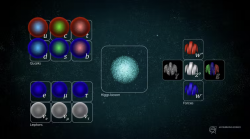Join our daily and weekly newsletters for the latest updates and exclusive content on industry-leading AI coverage. Learn More
By all measures, 2024 was the biggest year for artificial intelligence yet — at least when it comes to the commercialization of the technology.
The large language model (LLM) boom spurred on by ChatGPT’s launch in late 2022 showed no signs of slowing down, with numerous new LLMs introduced by not just OpenAI and stalwart tech giants such as Microsoft, Meta and Google, but also scores of other startups and individual developers.
Reports of AI research slowing proved to be, if not unfounded, certainly overstated for now.
In addition, new technologies beyond the Transformer architecture that underpins most big LLMs began to surface, such as Liquid AI’s Liquid Foundation Models.
And finally, firms began to fully embrace the “agentic” approach to AI — developing specific AI powered bots, applications, and workflows that can work on specific problems independently, or with less human stewardship than the typical back-and-forth of LLM chatbots.
Distilling the year’s news stories down to a top 14, much less a top 10 or top 4, was a vexing effort. But I’ve gone ahead and tried, albeit cheating slightly by combining several stories into larger themes. In my eyes, here’s what will make the largest impact moving out from this year:
1. OpenAI expanded far and wide beyond ChatGPT
The company arguably most responsible for kicking off the gen AI era didn’t miss a beat this year, despite intensifying competition from newbies and legacy tech, even its own investor and partner Microsoft.
o1 Model: OpenAI released its first new family of large general purpose models beyond its GPT series, the o1 “reasoning” series, which allocates more time to process complex prompts, resulting in higher accuracy. It’s particularly effective in science, coding, and reasoning tasks.
o3 Model: It followed the o1 model from September with a blockbuster end-of-the-year announcement of an even more advanced o3 model. While this won’t be availably publicly or even to any third parties till early 2025, it shows OpenAI is not resting on its laurels.
ChatGPT Search: This feature, initially launched as an invitation-only stand alone product called SearchGPT before being collapsed into ChatGPT proper, enables more real-time web information retrieval within ChatGPT and a refined presentation of search results, enhancing its utility for up-to-date queries and going head-to-head against Google, Bing, and newcomer Perplexity.
Canvas: Introduced in October, Canvas expands the ChatGPT interface beyond that of a conversational one to a workstation like pane that can update content dynamically at the user’s request, such as editing a document or coding project. Of course, it was hard not to see it as a reaction to, or at least a comparable feature to Anthropic’s Artifacts announced several months prior.
Sora: After nearly a year of teasing us with its closely guarded video generator model, OpenAI in early December finally launched Sora to the masses, quickly inviting a wide range of reactions as it sought to differentiate in a hotly competitive AI video space with a unique and well thought-out interface and storyboarding feature.
2. Open source AI took off
Llama 3 and 3.1: Meta introduced Llama 3 in April, setting a new standard for performance in open source AI, then followed it up quickly with Llama 3.1 in July with 405 billion parameters. Versions of Llama 3.1 were used to power Meta AI, the company’s assistant integrated across platforms like WhatsApp, Messenger, Instagram, and Facebook, aiming to become the most widely used AI assistant.
Llama 3.3: Released in December 2024, Llama 3.3 delivered performance comparable to larger models but at a fraction of the computational cost, making it more accessible for enterprise applications.
Meanwhile, Chinese models such as Alibaba’s Qwen-2.5 family and DeepSeek’s new V2.5 and R1-Lite Preview appeared seemingly out of nowhere to top some of the benchmark charts, and Nvidia itself went beyond supplying graphics cards and software architectures to launch its own open source, powerful Nemotron-70B model.
Nous Research, a small outfit in San Francisco aiming to offer more personalized and less restrictive AI models as open source, also debuted several cool new ideas.
And let’s not forget France’s Mistral, which rapidly expanded its own open source and proprietary AI offerings.
3. Google’s Gemini series became a serious contender for the best available
In the comeback story of the year, Google’s Gemini series of AI models that were once mocked for their strange image generations and criticized for being overly “woke” came back roaring with new, more powerful versions that now top the third-party performance benchmark charts and are increasingly appealing to developers and businesses.
Google introduced Gemini 2.0 Flash, a multimodal AI model that supports streaming video analysis and can see and instruct what you’re doing on your screen, and followed it up with Gemini 2.0 Flash Thinking that competes with OpenAI’s o1 and o3 reasoning models.
4. Agentic AI swept the enterprise
As the year went on, “agentic” AI went from being a buzzworld to a real series of major product announcements and initiatives by top enteprise software vendors. Take for example:
Salesforce’s Agentforce 2.0: Salesforce unveiled Agentforce 2.0 a few days ago, an advanced AI agent program to enhance reasoning, integration, and customization features across its CRM and sales offerings, as well as Slack, significantly improving enterprise productivity tools.
SAP’s Joule: SAP converted its Joule chatbot into an AI agent powered by open-source large language models (LLMs), driving innovation and efficiency in enterprise settings.
Google’s Project Astra: As part of the Gemini 2.0 initiative, Google launched Project Astra, an AI assistant designed to provide real-time, contextual responses by leveraging Google’s suite of services, aiming to enhance user productivity and decision-making.
My big prediction for 2025: AI generated content will reign supreme
Building upon these advancements, 2025 is poised to witness the proliferation of AI-generated content across business and consumer domains, especially as everyone from OpenAI to Meta, Google, Microsoft, Apple, even Elon Musk’s xAI now has AI image generators built in to their offerings.
This expansion will streamline content creation, enhance personalization, and drive efficiency in various sectors.
Additionally, we anticipate the initial large-scale deployments of large language models (LLMs) and generative AI-powered robotics in both commercial and consumer settings, revolutionizing automation and human-robot interactions.
That’s all in the last #AIBeat newsletter for 2024. Thanks for reading, writing, subscribing, sharing, commenting, and for being here with us. Looking forward to sharing more and hearing more from you all in 2025.
Happy holidays and New Year from all of us at VentureBeat to you and your loved ones.










Leave a Comment